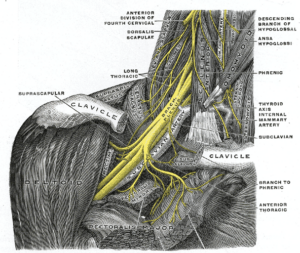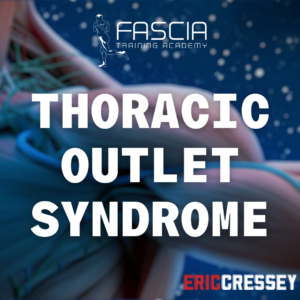
Random Thoughts on Sports Performance Training – Installment 35
In this installment of Random Thoughts on Sports Performance Training, I want to hone in on shoulder stuff because, well, that’s what I talk about a lot! Before we get to it, here’s a friendly reminder that my Thoracic Outlet Syndrome course is on sale for $50 off through tonight at midnight. You can check it out HERE – with the discount automatically applied.
Now, let’s get to the content:
1. The neck is the easiest place to start with cleaning up shoulder movement.
I’ve written a lot in the past about how our arm care programs work proximal to distal, meaning that we focus on the center of the body before the extremities. Usually, the right proximal changes yield immediate distal improvements both via reducing protective tension and reducing stiffness in the muscles we’re trying to “overpower” to create good movement. Usually, though, when it comes to proximal changes, folks look at the thoracic spine and rib cage only. In reality, the cervical spine ought to take precedence over both of them – particularly because all the nerve of the upper extremity originate from the brachial plexus, which ranges from C5 to T1.
Fortunately, while it might be anatomically correct, coaching optimal positioning in the neck is actually very simple in the context of weight training and arm care drills: get it to neutral and keep it there. In 99% of cases, that means getting people out of upper cervical extension, which fires up the levator scapulae (which competes against all the scapular upward rotation we want). Here’s a video that walks you through what you need to know:
The thoracic spine and rib cage are sexy right now, but the cervical spine is an older, reliable option for cleaning up movement quickly in just about everyone.
2. Whenever possible, get core control integrated in your arm care drills.
I often come across arm care protocols that literally have athletes laying on a table for 30 minutes worth of “exercise.” This not only leads to a disengaged athlete, but also overlooks the fact that the entire kinetic chain needs to be synced up to keep a shoulder healthy. We’ll often use predominantly table-based exercises in month 1 to make sure athletes are picking up the technique in a controlled environment, but in almost all scenarios, these table drills are actually “fillers” between sets of strength training exercises that have the athletes up and around in the gym.
More importantly, after that first month, I try to make sure that at least half of our arm care exercises are done separate from the table. Maybe we do our horizontal abductions in a side bridge position, or integrate more bottoms-up carries or bear crawls for serratus activation. Perhaps the prone trap raises take place on a stability ball, or we could move the athlete to half-kneeling, split-stance, or in a rear-foot elevated position for their 90/90 external rotation holds.
Regardless of what we choose, the buy-in from athletes is definitely better – and just as importantly, the resulting training effect has a more specific carryover to sporting success.
3. Yet another study reminds us that GIRD is a measurement and not an actual pathology.
Glenohumeral internal rotation deficit (GIRD) was all the rage in the baseball sports medicine community for decades. Unfortunately, what many practitioners fail to appreciate is that GIRD can be a completely normal finding as long as an individual’s total motion is symmetrical between throwing and non-throwing shoulders. We expect to see less internal rotation and more external rotation in a throwing shoulder because of retroverion in the throwing shoulder; the arc is just shifted. Here’s a glimpse at what it looks like:
Anyway, we are now at a point in time where more and more research on GIRD is out there, and it’s pretty resounding: it doesn’t predict injury as well as we once thought. And, more importantly, the opposite seems to be true: a loss of external rotation (usually from a combination of less retroversion and soft tissue limitations) equates to a greater injury risk. We need to get more of the “GIRD? So What?” literature into the hands of doctors who aren’t familiar with the latest research, as many are still making “GIRD” diagnoses when they really are just range-of-motion measurements. I delve into this in great detail in the Sturdy Shoulder Solutions product, but figured another study reiterating the point can’t hurt. This one – Relationship Between Glenohumeral Internal Rotation Deficit and Medial Elbow Torque in High School Baseball Pitchers – just found that GIRD wasn’t associated with medial elbow torque in high school pitchers.
It’s time to move on from GIRD!
4. If you’re about to have shoulder surgery (or any surgery), get your Vitamin D checked.
For years, we’ve known that having an adequate Vitamin D status was important for a myriad of biologic functions. Perhaps the most well known among observations on this front was a 2015 study of NFL players that demonstrated that players with inadequate preseason Vitamin D levels were more likely to have suffered a lower extremity or core muscle injury. In fact, the likelihood of a hamstrings injury was 3.61 higher in those with inadequate vitamin D levels! As such, it’s become a big area of focus in the nutrition and supplementation world for athletes.
However, I’ve honesty never heard of an orthopedic surgeon looking at it for those who either have chronic pain or are about to undergo a surgical intervention to treat a structural defect. We need to change that, though. A recently published study, Preoperative Vitamin D Deficiency Is Associated With Higher Postoperative Complications in Arthroscopic Rotator Cuff Repair, should help in that goal, though. Patients with pre-operative Vitamin D deficiency were 1.54 times more likely to require a revision surgery and 1.16 times more likely to require manipulation under anesthesia to overcome post-op stiffness.
Clearly, Vitamin D has a huge link to soft tissue health, so don’t overlook it!
Wrap-up
I’m a shoulder nerd and could ramble on all day on this stuff, but instead, I’ll direct you to my currently-on-sale course, Thoracic Outlet Syndrome: Diagnoses and Treatments. You can save $50 off the normal price through tonight at midnight.




